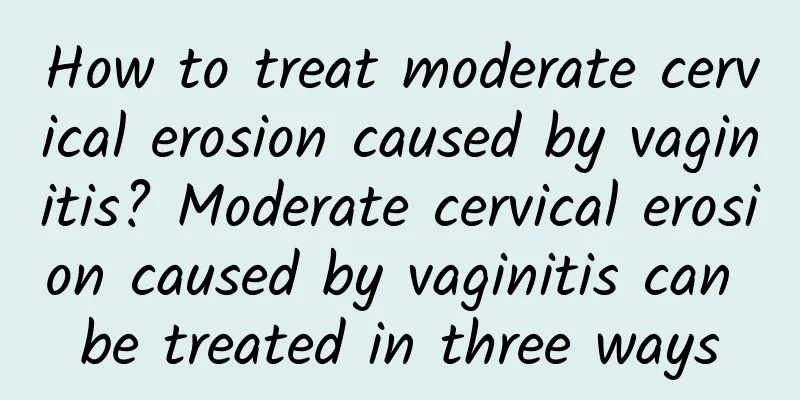What are the symptoms of uterine posterior wall adenomyoma? What are the causes of uterine posterior wall adenomyoma?

|
What are the symptoms of uterine posterior wall adenomyoma? What are the causes of uterine posterior wall adenomyoma? Uterine fibroids are a common female disease, and posterior uterine adenomyosis is one of the most common types. This article will focus on the symptoms and causes of posterior uterine adenomyosis. 1. Symptoms of adenomyoma of the posterior uterine wall 1. Abnormal menstruation: Patients with adenomyoma on the posterior wall of the uterus may experience abnormal menstruation, such as excessive or insufficient menstrual flow. The reason is that the fibroids are located on the posterior wall of the uterus, compressing the uterine cavity and causing menstrual irregularities. 2. Pain: Patients with adenomyoma on the posterior wall of the uterus may feel pain in the pelvis or lower back. When the fibroids grow larger and compress the surrounding tissues, it can cause discomfort and pain. 3. Frequent urination and difficulty in defecation: If the uterine posterior wall fibroids begin to compress the bladder, the patient may experience symptoms of frequent urination. When the fibroids compress the rectum, defecation may become difficult. 4. Sexual problems: Adenomyosis on the posterior wall of the uterus may cause discomfort or pain during sexual intercourse. Compression of pelvic tissue may cause pain and affect the quality of sexual life. 5. Abdominal mass: When the uterine posterior wall fibroids are large or numerous, the patient may feel a mass in the abdomen. This is a mass caused by the presence of fibroids. 2. Causes of uterine posterior wall adenomyosis 1. Genetic factors: Studies have found that personal genetic background and family history are associated with the formation of uterine fibroids. Women with family members suffering from uterine fibroids are more likely to develop adenomyoma of the posterior uterine wall. 2. Hormone levels: Estrogen is the main driving force in the formation of uterine fibroids. The formation of uterine posterior wall fibroids is related to the imbalance of glucocorticoids, progesterone and ovarian hormones, which can cause the endometrium to thicken, thereby promoting the growth of fibroids. 3. Age factor: Age is an important factor in the occurrence of uterine fibroids. As women age, their risk of developing uterine fibroids increases. The formation of uterine posterior wall fibroids is related to changes in hormone levels and endometrial growth. 4. Other factors: Obesity, dietary habits, and reproductive history may also affect the occurrence of uterine fibroids. Obesity is associated with the formation of adenomyomas on the posterior wall of the uterus, and high sugar and high fat intake in dietary habits may increase the risk of disease. In addition, women who have never been pregnant or have never given birth are also more likely to develop uterine fibroids. in conclusion: In summary, the symptoms of posterior uterine wall adenomyoma include menstrual abnormalities, pain, frequent urination and difficulty in defecation, sexual problems and abdominal lumps. The formation of posterior uterine wall adenomyoma is related to genetic factors, hormone levels, age and other factors. For women with posterior uterine wall adenomyoma, regular examination and diagnosis are necessary to detect and treat this disease early and maintain women's health. |
>>: What kind of wine is effective in treating uterine fibroids? What can cure uterine fibroids?
Recommend
Things to note in daily life after abortion
Artificial abortion is what people often call abo...
Is it dangerous to have a painless abortion for a scarred uterus? Can I still get pregnant?
There are certain risks in painless abortion for ...
Losing weight too early after childbirth can cause your milk to become less and thinner
After giving birth, many women are eager to chang...
How to Prevent Ovarian Cysts
How to prevent ovarian cysts? Most ovarian cysts ...
Do you know the relationship between female leucorrhea and vaginitis?
What is the relationship between female leucorrhe...
How to treat the causes of cervical hypertrophy
The simple cause of cervical hypertrophy will not...
Lose 8,000 calories in 3 days to prevent overtraining syndrome
Cycling is a good way to burn calories. Travel sh...
It is a waste to only use it for soothing the throat. Loquat has three other benefits.
What should you do if your throat gets stuck when...
Introduction: Three main symptoms of cervical hypertrophy
Clinically, the symptoms of cervical hypertrophy ...
What are the causes of irregular menstruation and how to regulate it
Menstrual disorders are a common disease among wo...
What should I do if my vagina becomes swollen and itchy after menstruation?
What should I do if my vagina becomes swollen and...
What should patients with pelvic inflammatory disease eat?
Patients with pelvic inflammatory disease must pa...
How much does it cost to treat dysfunctional uterine bleeding?
If you suffer from functional uterine bleeding, i...
Apply force to the 4 major areas correctly and run to get a sexy figure!
Road running is a sport that burns fat. Long-term...
How to choose a hospital that can treat vulvar leukoplakia
How to choose a hospital that can treat vulvar le...









